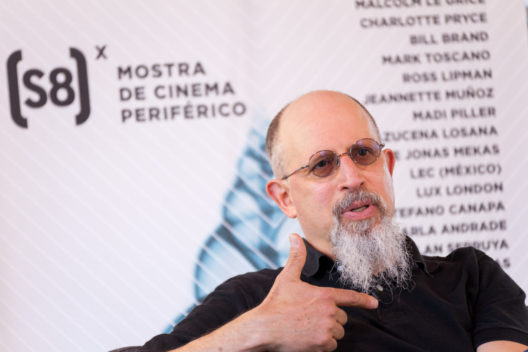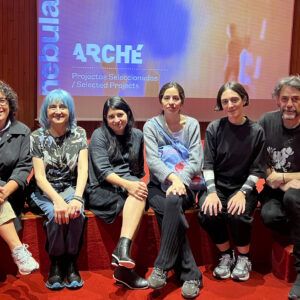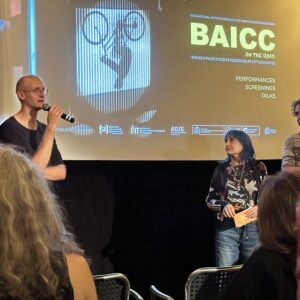
How you came up with the idea of the kind of performative lecture you’ll be offering?
I’ve always been very inspired by the long tradition of illustrated lectures, which goes back many hundreds of years, within film history. But within history, you have also the history of the clip lecture, which I guess would be a middle step between the magic lantern performance and the documentary film, so to speak. And you’d get film historians, or art historians presenting slide shows. So a couple of major influences on me were, for example Rudolf Arnheim –I was one of the last students of the great film theoretician Rudolf Arnheim, who wrote Film as Art back in 1933, and he would do this wonderful illustrated lectures on art history, with different slides illustrating different theories and putting them in relationship to each other, so it wasn’t just one picture and then another, you created a dialectic of ideas through the way he would juxtapose the images and the texts that he was presenting. Another big influence was Bob Gitt, who was the founder of UCLA’s restoration department. I was privileged to work at the UCLA film and television archive with Bob Gitt, who was a master at this form of taking clips from film history and then weaving it into a context. Perhaps I pushed it more towards the direction of live documentary, and of course that’s now a form that’s coming into its own as well.
Could you tell us more about how you structure your lectures? They have a noticeable rhythm, a pace, a sense of structure and even of entertainment. Could you elaborate on that?
There’s different aspects to that. The rhythm that you’re speaking of is developed in the construction of the piece, but also I rehearse a lot, everything is carefully coordinated. So, for example, I have a text that I work from. I don’t try to memorise the text, I do work from a written text rather than memorising it, because I don’t do them frequently enough to memorise them, and also I want to know what I’ll be doing, so Thom Andersen once made this joke to me about it: “The only thing that makes this a live performance is when you make a mistake”. And I kind of take his point… If I’m so careful about planning everything, why do them live? But there is a little bit of spontaneity that comes, and, you know, I think that people like the presence of a having a person speaking to them live. As far as the overall structure, that’s determined entirely by the piece, so for example the one that I’ll be presenting at this festival, The Exploding Digital Inevitable was designed really to allow Bruce Conner’s Crossroads to shine, of course. This project began when I worked with Michelle Silva and the Bruce Conner Trust in UCLA to restore Crossroads. So in the process of restoring Crossroads, I found all this excellent material on the background, with the help of Michelle, who was an expert on all this material, and the structure grew from there, because it’s really important that Crossroads speaks for itself, and so what I did is I came up with a structure of three parts: the first part is an introduction to the history of the atomic bomb, and a little bit about these crossroads, but not too much about Crossroads itself, because it’s very important that the audience have the experience of seeing Crossroads without me having coloured their perception of it. If I say too much of what I think in advance, that might interfere with the audience’s perception of the work. So then, we see Crossroads, and finally, at the end, then I talk about the making of Crossroads and adventure into some interpretations. Another key consideration for this particular work is that I used almost no music, especially in the first half, because the score, the music of Crossroads, is such an important part of that work, and if I filled up this part of the documentary with a lot of other music, I think it would really distract from the experience of Crossroads. So I let a little bit happen in the second half. I want the audience to walk away with experiencing Crossroads in a larger context, still having that experience of the film itself.
What would you say were the main challenges while restoring Crossroads?
I guess that one of the interesting things that I should say about the Bruce Conner work, which distinguishes it from all the other preservation of film in general, and even experimental film, is that we’ve been working in that structural model of retroactive editioning. Bruce Conner did explore creating limited editions of his film works, during his lifetime. And that was where the ideas originated from. But what The Conner Trust has been doing is creating multiple-version restorations, in which we do everything in 35 mm film, and that also parallel a digital remaster in 4K. I do all my projects trying to achieve the highest quality for both picture and sound, but in the case of the Conner work we are able to do this with multiple-format editioning: we create one version in 35 mm, another one in 4K… and they are qualitatively a little bit different, each medium is slightly different. I use to say that you can’t restore something into a medium in which it has never existed, so if you do a digital-only restoration of a film work, it’s an oxymoron. You can’t say you restored it. That would be digital remastering. With The Conner Trust, we are doing both, and part of this was enabled, through Bruce Conner’s position as a notable artist in the art world. In the art world, you can command much larger prices, and so we’re not getting grants to fund this work. The Conner Trust sells are restorations in small quantities for large sums of money to the world’s largest art museums. And it’s because of that that we’re able to maintain the quality standards that we’re able to maintain.





